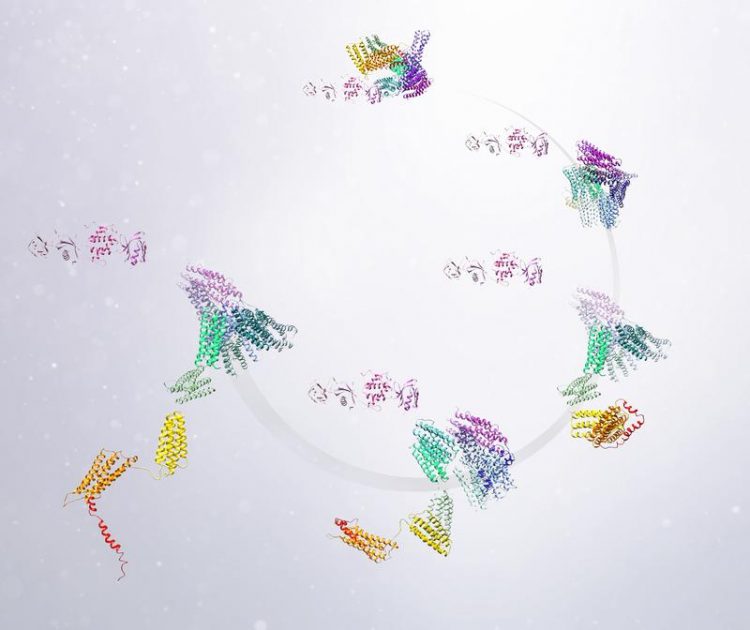New structural data on talin explain self-inhibitory mechanism

Regulatory mechanism of talin: from the spherical, inhibited state to the elongated and active form Picture: ©Naoko Mizuno, MPI of Biochemistry
All complex organisms are made up of cells that are in contact with each other or with structures in intercellular spaces. Cells have contact points on their surface that enable them to maintain physical contact with their environment.
However, these connections are dynamic, not static. A finely regulated process of cellular attachments and detachments is particularly important during cell migration, cell development, immune responses and blood clotting. For this reason, the contact points form an elaborate protein machinery.
Talin and integrin, two key proteins in the cellular adhesion machinery, have been the subject of much research in recent years.
Together with her team, Naoko Mizuno, head of the “Cellular and Membrane Trafficking” Research Group at the Max Planck Institute of Biochemistry, has now elucidated the structure and regulatory mechanism of talin with the help of cryo-electron microscopy.
“Although talin is recognized as key for the cell migration, its regulation was enigmatic as the architecture of the molecule as a whole was unknown,” Mizuno says.
Dirk Dedden, lead author of the study, comments: “We’ve focused on analyzing the protein as a whole. Using a variety of modern biophysical techniques, we’ve discovered which environmental conditions cause the protein to alter its state reversibly.”
Thanks to controllable laboratory conditions, the scientists have now been able to determine the protein’s precise molecular structure by means of cryo-electron microscopy.
Talin, like a mechanical spring, is spherical in shape in its inactive form and oblong in its active state. The researchers have now been able to identify which areas of inactive talin are shielded from the environment in its spherical self-inhibitory state.
This means that neighbouring proteins are unable to interact with the molecule, and the cell itself is unable to adhere to surrounding tissue. In its elongated active form, the molecule acts as a binding platform for neighbouring proteins, which furthermore promotes attachment of the cell to its surrounding structures.
Naoko Mizuno explains: “Given that the cellular adhesion process no longer functions properly in some diseases, notably cancer, our results will hopefully have long-term medical benefits.
Talin is known to activate integrin, and integrin is a well-known target for some anticancer drugs. We hope that an understanding of the regulatory process of the adhesion mechanism will shed light on disease processes and lead to new treatments.”
Naoko Mizuno, PhD
Cellular and Membrane Trafficking
Max Planck Institute of Biochemistry
Am Klopferspitz 18
82152 Martinsried
Germany
E-Mail: mizuno@biochem.mpg.de
http://www.biochem.mpg.de/en/rg/mizuno
D. Dedden, S. Schumacher, C. F. Kelley, M. Zacharias, C. Biertümpfel, R. Fässler, N. Mizuno: The architecture of talin1 reveals an autoinhibition 1 mechanism. Cell, September 2019
https://doi.org/10.1016/j.cell.2019.08.034
Media Contact
More Information:
http://www.biochem.mpg.de/All latest news from the category: Life Sciences and Chemistry
Articles and reports from the Life Sciences and chemistry area deal with applied and basic research into modern biology, chemistry and human medicine.
Valuable information can be found on a range of life sciences fields including bacteriology, biochemistry, bionics, bioinformatics, biophysics, biotechnology, genetics, geobotany, human biology, marine biology, microbiology, molecular biology, cellular biology, zoology, bioinorganic chemistry, microchemistry and environmental chemistry.
Newest articles

Silicon Carbide Innovation Alliance to drive industrial-scale semiconductor work
Known for its ability to withstand extreme environments and high voltages, silicon carbide (SiC) is a semiconducting material made up of silicon and carbon atoms arranged into crystals that is…

New SPECT/CT technique shows impressive biomarker identification
…offers increased access for prostate cancer patients. A novel SPECT/CT acquisition method can accurately detect radiopharmaceutical biodistribution in a convenient manner for prostate cancer patients, opening the door for more…

How 3D printers can give robots a soft touch
Soft skin coverings and touch sensors have emerged as a promising feature for robots that are both safer and more intuitive for human interaction, but they are expensive and difficult…





















